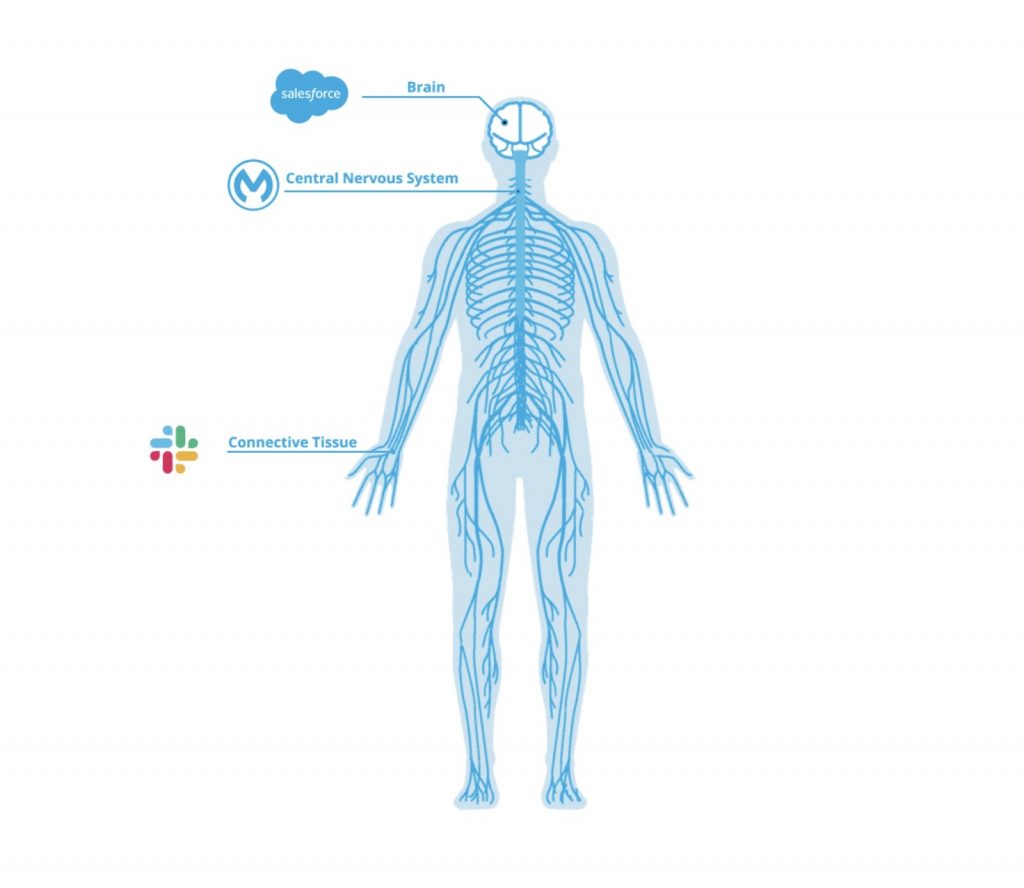It’s a momentous day for us. Salesforce has officially acquired Slack after the initial announcement was made back in December 2020. Personally, I am very excited for what the future holds with Slack as a Salesforce company, and I can’t wait to welcome Stewart Butterfield and Slack to the Salesforce family.
With the acquisition now finalized, you might be wondering what the impact is on MuleSoft? I wanted to share our thoughts on what the future holds for MuleSoft and Slack, as part of the broadening Salesforce portfolio.
The body of an enterprise
Slack’s technology has played an integral role in keeping organizations agile during the pandemic by enabling them to organize their people and their work in this evolving digital-first and work-from-anywhere world.
This is why we can’t wait to bring Slack into the Salesforce portfolio, so that collectively we can reimagine how teams work together to deliver incredible customer and employee experiences.
At MuleSoft, we’ve also been essential for organizations looking to digitally transform in this period of disruption. We help organizations deliver a composable enterprise, enabling them to connect all of their applications, devices, and data as composable building blocks that allow them to be significantly more agile and efficient.
We see ourselves as the central nervous system of this composable enterprise, where all of the connected applications are the organs. When an event occurs in one organ of the body, this event travels through the body by way of this central nervous system. When all your applications are connected in this way, the system acts as a whole. When not deriving anatomical metaphors to explain it, we call it the application network.

So where does Slack fit in this physical analogy? We see Slack as the connective tissue that layers on top of this nervous system and connects the network of applications to the people that need to interact with them. This means that when events are triggered from within the nervous system, they can reach a person as easily as they can another application.
Essentially, we bring the human network together with the application network.
Collaboration and integration are better together
Slack already has out-of-the-box integration capabilities, with thousands of apps available in the App Directory. These apps are great and make it easy to quickly find, share, and act on information across your enterprise ecosystem.
For many users and organizations, the integration capabilities that Slack offers are enough to meet their needs. We only look to extend and add additional value to these capabilities, not replace them.
In Slack’s app ecosystem, organizations can build valuable integrations between Slack and one other system to solve a particular problem. By extending these capabilities with MuleSoft, these organizations can orchestrate complex multi-system integrations to take these integrations quite a few steps further.
The other reality is that many integrations require significant customization, complex logic, and/or these integrations have use across multiple departments. Slack’s current workflow builder is not optimized for these use cases and this is where, for developers within IT, the full power of MuleSoft’s Anypoint Platform is on display.
Using Anypoint Platform, developers can build sophisticated and reusable integrations to extend the capabilities of Slack. As with everything in Anypoint Platform, there’s a combination of a declarative UI and the ability to roll your own code. See how this all comes together in the demo below. With Slack and Anypoint Platform, anything is possible.
Everyone is invited to join in
In addition to this, MuleSoft also empowers the line of business and we firmly believe they are critical to keeping up with the pace of innovation. With MuleSoft Composer for Salesforce, multi-system integrations can also be built by line of business users with clicks, not code. This enables more innovation to flourish and takes the pressure off IT, allowing them to deploy their critical skills towards more technical problems.
A good example of this is in the service ops team. These teams are more strategic than ever before, as they are expected to continually optimize the service experience to respond to the changing landscape — and we’ve seen how much it has changed in the last year alone.
One of the hardest problems to solve for service agents is the dreaded swivel chair. Agents are often having to swivel between Service Cloud for case management, JIRA for incident tracking, and Slack for case swarming — to synthesize all of the information required to service the customer.
With MuleSoft Composer for Salesforce, organizations can automate the integration of all these systems with a few clicks, so that both the primary application that each team uses stays up to date, but that these teams can interact and collaborate throughout using Slack.
And most importantly, the service ops teams can continue to optimize these integrations themselves, as they work hand-in-hand with the agents and identify new opportunities for improvement. This is innovation in flight. We’re so excited for the future of MuleSoft and Slack at Salesforce. When you can elegantly orchestrate people and systems, you have the fullest expression of the composable enterprise — one that is agile and innovative and is best positioned to deliver an incredible experience for its customers and employees.









